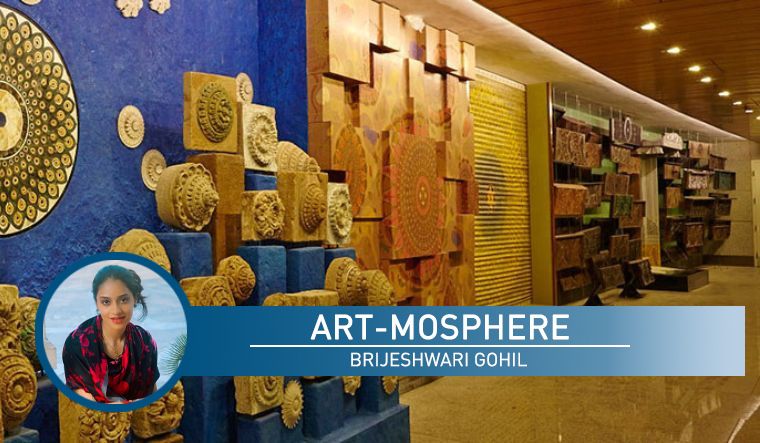Art works at airports are perhaps the best result of privatisation. But do they cater to anyone else other than a selfie seeker?
There is chaos in Mumbai’s airport. Terminal 1 thankfully has less mayhem than Terminal 2 where I am told the recent Vistara cancellations have caused fury and rage amongst flyers. The airport is packed and the flight to my hometown Bhavnagar is yet again delayed.
Being a perpetually tardy passenger, waiting at an airport is tremendously boring for me. I find myself pacing between the Coco Cart Cafe (a saving grace for every coffee lover) and my boarding gate. I glance up at a wall, which I may have crossed five if not more times in the past 15 minutes, and look at the two paintings displayed. I am simply stunned.
For some obscure reason, I had completely missed noticing these gorgeous paintings. At the bottom right, the art works are signed by the late Lalitha Lajmi. I look around me at the many other travelers, passing by, glued to their mobile phone screens or simply making a dash to the gate. How many of these passengers would have noticed these fabulous works of art?
Lalitha Lajmi passed away last year in February. An artist whom I had the pleasure of interacting with on several occasions, she was one of the many underappreciated artists of India. Sister to the legendary actor and director Guru Dutt, Lajmi was a self-taught artist hailing from a simple background. She explored the complexes of humanity through a range of mediums. Her last exhibition being a retrospective at the NGMA, Mumbai, which took place in January 2023, just a month before her passing. As I glanced at her two large canvases, I felt an overwhelming sense of sadness as I thought these works deserved a far better audience.
What is the end goal of having airports impeccably curated with art works? Are they in competition with a museum?
The beautiful International airport (Terminal 2) in Mumbai, for example, houses a treasure trove of art works and a very well-appointed art conservation laboratory. Limited airports in the world have this infrastructure and luxury, with an air of sprezzatura. One
of the world’s busiest airports, Los Angeles International, has been designed with a similar ethos – that of celebrating culture and local, regional artists.
Mumbai’s T2 is an exploration of Indian tradition, craft and culture. The elegant manner in which, beautiful, intricate metal embossed boxes or ‘pataras’ (as they are known in Gujarat) are displayed over the luggage belt. A juxtaposition to the rough and crude manner by which the
incoming suitcases are handled on the belt. A combination of folk art, craft and contemporary art, the airport is a gratifying experience for a culture vulture.
It is vital that art gets out of the intimidating, even boring, confines of a museum and is brought directly to people. But how many art lovers, let alone people with no interest, have the time and bandwidth to relish art at an airport? While public programmes such as these would give emerging and young artists a platform to have their works exhibited, is it worth the exercise?
Are we wasting our resources and underselling our artists by having prized works, deeply studied narratives be part of a place where people are only interested in reaching from point A to point B? Artists, pride themselves showcasing at museums or perhaps even public spaces. But I’ve heard none take pride in their work showing up at the departure terminal.
I was impressed to see the new Bangalore International Airport, which has collaborated with the State Archaeological Department to display some exquisite works of historic significance. The Greeks have followed a similar concept of showcasing archaeological finds at the Athens airport. It may serve as the best bet for a passenger in transit to have a little cultural exposure. It may also help the airport build a distinct cultural identity. A celebration to Karnataka’s regional heritage, the airport even offers a walk through similar to a museum and gallery.
But most in transit are worried about missing their next flight. Would they stop and stare? I see many passengers take selfies with the art works, without even stopping at the panel to read the artist’s name?
Airports seem to be racing ahead of cities in glamorising art. Should we not be investing in cultural heritage sites and museums as places of visiting before we showcase our airports? Is this opulence the result of privatisation ?
Airports might have the power to educate a lay person with no cultural interest and it may also inspire another to study art or draw inspiration from what is being displayed.
Given the many psychological benefits of exposure to art, airports may organically aid in reducing stress, especially while travelling. There is a dedicated group of researchers who study neuroaesthetics and the positive impact of high visual stimulation. Analysing the
impact of art and the new neural pathways, it helps develop, these researchers credit art exposure to considerable improved mental well-being.
Our surroundings play such an integral role in inspiring the creative within each one of us. It is probably why most great artists and literaries found solace in nature. For the population living in concrete jungles, airports might hopefully evolve to be that haven.
Until then, we satisfy the selfie seeker.


